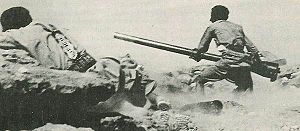North Yemeni Civil War
| North Yemen Civil War | |||||||
|---|---|---|---|---|---|---|---|
| Part of the Arab Cold War | |||||||
 Royalist Yemeni forces try to repel an Egyptian armored attack |
|||||||
|
|||||||
| Belligerents | |||||||
|
Supported by: |
Supported by: |
||||||
| Commanders and leaders | |||||||
|
|
|
||||||
| Strength | |||||||
|
Hundreds of mercenaries financed by United Kingdom |
|
||||||
| Casualties and losses | |||||||
|
|
|
||||||
| 100,000–200,000 killed | |||||||
Republican victory
The North Yemen Civil War (Arabic: ثورة 26 سبتمبر) was fought in North Yemen from 1962 to 1970 between royalist partisans of the Mutawakkilite Kingdom and supporters of the Yemen Arab Republic. The war began with a coup d'état carried out in 1962 by revolutionary republicans led by the army under the command of Abdullah as-Sallal, who dethroned the newly crowned Imam Muhammad al-Badr and declared Yemen a republic under his presidency. The Imam escaped to the Saudi Arabian border where he rallied popular support from northern Shia tribes to retake power, escalating shortly to a full-scale civil war.
On the royalist side Jordan and Saudi Arabia supplied military aid, and Britain gave covert support, while the republicans were supported by Egypt and were supplied warplanes from the Soviet Union. Both foreign irregular and conventional forces were involved. Egyptian President Gamal Abdel Nasser supported the republicans with as many as 70,000 Egyptian troops and weapons. Despite several military actions and peace conferences, the war sank into a stalemate by the mid-1960s.
...
Wikipedia
